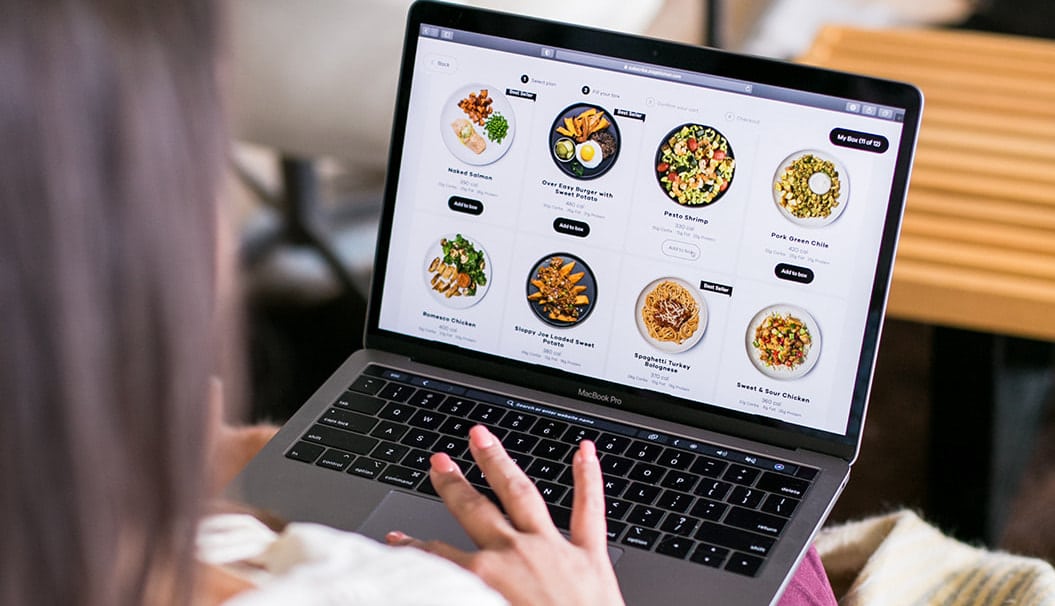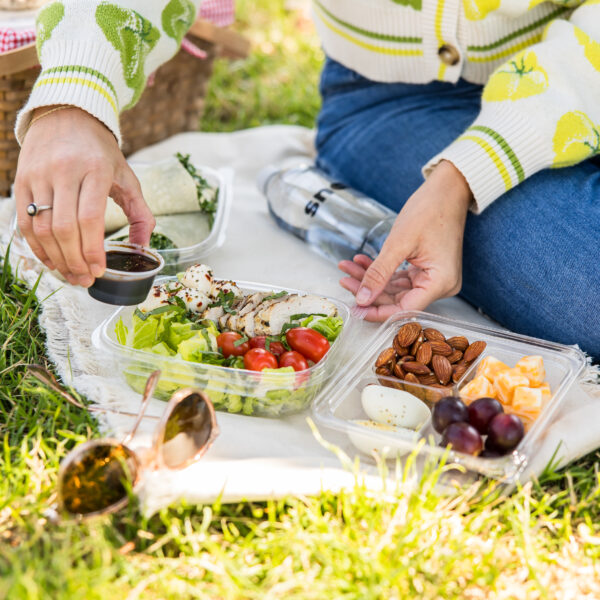It’s that feeling of being hungry every couple of hours, low on energy after full meals, or struggling through your workouts. It’s hunger, and the reasons why you’re feeling it so often likely has to do with what’s on your plate. However, you’re not alone! With all the nutrition noise out there, it’s no wonder people are confused about what constitutes a nutritionally balanced diet. Here at Snap Kitchen, we’re all about healthy portion meal sizes and well-balanced nutrition. And that includes proper servings that help you stay full, focused, and able to take on the day between meals.
At the core of any balanced meal plan are three main things: vegetables, protein, and healthy fats.
Vegetables: You Can Never Have Too Many
Have you ever noticed that vegetables are the one thing that most people can agree on? Whether you’re vegan, paleo, or somewhere in between, it’s pretty commonly accepted that veggies = goooood for you!
There are two main types of veggies: starchy and non-starchy. Non-starchy veggies are leafy greens, broccoli, cauliflower, and cucumbers. Starchy veggies are plantains, butternut squash, and beets. Starchy veggies are higher in carbohydrates, but they’re the healthiest form of carbs that you can find!
If you’re an athlete, are extra active, or simply trying to include more healthy carbs in your day, you can swap your bread, pasta, and other refined starches for veggies instead.
What’s the Right Amount of Carbohydrates?
Aside from veggies, a few of our favorite carb sources include fruit, gluten-free grains, and beans! It’s always important to balance the starchy carbs on your plate with protein and fat to balance your blood sugar and keep you full between meals. I like to call this concept no ‘naked’ carbs because it’s a helpful reminder to avoid eating a carbs-only plate.
These carbs are best served as your side dish rather than as the focal point of the meal. Aim for about ¼ or less of your plate as non-veggie carbs.
How Much Protein is Too Much?
In my professional experience, most people don’t eat enough protein at most of their meals or stack all of their protein at the end of the day. Instead, it’s best to include high-quality protein in every one of your meals. The exact amount depends on the individual, but the average person will benefit from ~100+ grams of protein per day, or roughly 30-35+ grams of protein per 3 meals a day schedule. This is the equivalent of 4-5 ounces of protein per meal.
Breakfast tends to be the meal where people are most likely to skimp on protein. Let’s say you eat two eggs. Each egg has 1 oz of protein, meaning you’re only getting 2 oz of protein in your breakfast. Not nearly enough protein to get your morning rocking or keep you full and craving free between meals! If you enjoy eggs, have three eggs with a couple of slices of pasture-raised bacon, or make homemade sausage patties and add one of those alongside your eggs.
I’m a big fan of considering breakfast meal 1, so I’ll often eat leftovers from the night before for breakfast. The fantastic thing about this is that it’s easier to get adequate protein. Look here, if you’re looking for morning routine ideas.
My favorite protein options include:
- Eggs
- Pork
- Seafood (Salmon, Sardines, Cod, Halibut, Mackerel, Tuna, Shrimp, Scallops, etc.)
- Beef
- Chicken
- Turkey
- Liver
- Wild Game
- Sausage (natural/additive-free OR homemade)
- If you are a vegetarian or vegan, rely on beans, lentils, and occasional organic soy. Keep in mind that beans and lentils are also a carb source, so be mindful of your portion here as well as the other carbs on your plate.
The Skinny on Fats
at, is the essential macronutrient that has been vilified for FAR too long. Our bodies and our brains need healthy fat at every meal. Not only does fat help keep you full, but it’s essential for hormone health, brain health, optimal blood sugar levels, and more.
But one of the problems with the idea of healthy fat is that some vastly different schools of thought about what exactly “healthy fat” means.
In my book, unhealthy fats include:
- Processed vegetable oils (like canola oil, corn oil, soy oil, and more)
- Margarine
- Trans fats
- Excessive polyunsaturated fats
It can get a little confusing since some mainstream health organizations (and even many of my fellow registered dietitians (RDs)!) recommend processed vegetable oils like canola oil.
See below for a list of some healthy fat options. You can cook with some of these or add them to your plate after cooking. We generally need at least two servings per meal, but just as with protein and carbs, this will be dependent on your unique context.
You will have to experiment with this on your own to figure out exactly how much it satiates you. If you have a serving of nuts on your salad, you can also include a serving of oil-based salad dressing. If you cooked your veggies in ghee, you could also include 1/4-1/2 of avocado if desired. There are no hard-and-fast rules other than to stop eating when you’re full and to use your hunger/fullness cues as information when building your plate. Serving size varies depending on the type of fat, but here are some general serving guidelines:
- Cooking fats/oils = 1 Tbsp
- Avocado ≈ 1/2 avocado
- Coconut milk = 1/4 cup
- Nuts = 1/4 cup
- Nut butters = 2 Tbsp
Examples of healthy fats:
- Cooking fats: Ghee, coconut oil, avocado oil, extra virgin olive oil, pastured animal fats (like lard, tallow, or duck fat)
- Avocado
- Olives
- Nuts & Seeds
- Coconut milk (and other coconut products)
- Fatty fish (including salmon, mackerel, and sardines)
- Pasture-raised red meats
- Egg yolks (yes! Eat the yolk)
Are Snacks In Between Meals Healthy?
It’s best to give your digestion a rest between meals. If you do end up needing to snack, still follow the no ‘naked’ carbs rule that I outlined earlier. For example, if you’re eating a cup of blueberries, eat them alongside some macadamia nuts. Not only will this snack be more satiating (aka it will keep you full longer), but it’ll help balance your blood sugar levels too.
#HowISnap
While Snap meals are all perfectly balanced on their own, I love giving them a little boost of healthy fat or added veg when I have the time! Some of my favorite additions include avocado, a drizzle of extra-virgin olive oil, some leafy greens, or olives! What are your fave Snap additions?
The Nutritionally Balanced Framework
It really can be as simple as protein, fat, and vegetables. That’s your framework. At the end of the day, you’ll have to play within this template to make it work for you. You may thrive on more fat, or you may thrive on more protein. You may feel better eating cooked veggies, or you may feel better eating them raw. We’re all unique! Use these guidelines as a baseline and tweak from there. The key is to listen to your body along the way.
Want to skip the work and buy great pre-made balanced meals instead? We have you covered. Our entrées contain 3-4+ oz of protein, veggies, and healthy fats, which sounds like a no-cook win in my book. Shop today!





Leave a Reply
2 Comments
How long do the meals last in the fridge once they get delivered?
And can they be frozen?
Hi Elizabeth! The meals typically last about a week once delivered. While we have not freezer-tested our meals, many of our customers have frozen them with success. Some ingredients freeze better than others, so it’s important to note that not all meals will maintain their flavor or texture after freezing and thawing. Please also note that the heating instructions are designed for fresh meals, so take extra precautions when reheating from the freezer.